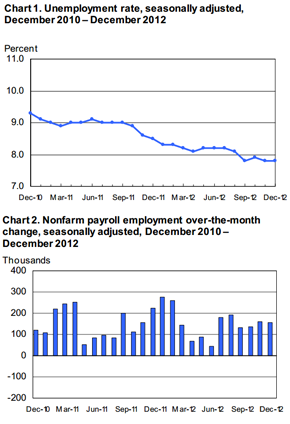Unemployment in December remained unchanged at 7.8 percent,
according to the Labor Department, while 155,000 new jobs were
created. In the private sector, 168,000 new jobs were created while
13,000 government positions were lost, mostly in local education.
December was the sixth month in a row of employment gains over
100,000, approximately the number needed to keep pace with
population growth.
 On the heels of Hurricane Sandy, residential construction
On the heels of Hurricane Sandy, residential construction
employment grew by 18,100, nearly two-thirds of the 30,000
construction jobs added during the month. When holiday sales fell
short of forecasts, though, clothing and clothing accessories
stores trimmed their December plans and total employment in the
category fell 18,700. Courier and messenger positions fell by
10,800 on a seasonal basis. Food services and drinking places added
38,000 positions, likely seeing some of the growth that retailers
did not. As has been the case for much of the last several years, a
larger portion of the job growth came from the healthcare sector,
where 44,000 positions were created.
While the total job growth remains slow, there is increasing
evidence that the quality of those jobs is improving. The number of
people working part-time jobs because of economic reasons fell by
220,000 during the month. Nearly three quarters of those being jobs
that were once full-time, became part-time, and now have returned
to full-time status. Average weekly hours have also edged up over
the last few months. In December, weekly hours increased from 34.4
to 34.5 hours.
Employment based on education during December remained largely
unchanged, with those holding a bachelor’s degree and higher seeing
a 3.9 percent unemployment rate for the second month in a row.
Unemployment among those with some college experience, but less
than a four-year degree, edged up from 6.6 to 6.9 percent. That
growth, though, was largely driven by an increased participation
rate, rather than decreased employment.
December’s employment report showed largely stable employment
across industries, which is kind of a remarkable feat considering
the overwhelming pundit discourse throughout the month projecting a
post-fiscal cliff recession. Yet, with such a negative outlook,
hiring continued, and employers utilized more of the employees they
do have to meet demand.
While Washington’s resolution of the fiscal cliff crisis was
less than definitive, we are now moving into a new year with a more
positive outlook than we have had for the last several years.

 Login
Login